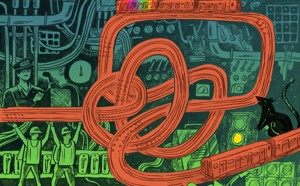
An alternate universe NYC subway train arriving at Columbus Circle on Tuesday night. (Photo: Benjamin Kabak)
After work last night, I took a trip to my old stomping ground on the Upper West Side to catch Mike LeDonne’s Hammond B3 organ quartet at the jazz club Smoke near 106th and Broadway. It’s been a Tuesday night tradition for over a decade now, and I’d highly recommend it. Usually, I’d take the 1 train from Midtown, but the MTA had a different idea. When the West Side IRT local pulled into Columbus Circle, the train proclaimed itself, oddly enough, a green 10.
A few passengers waiting for the train did a double-take, similar to the surprised looks that fill unsuspecting subway riders’ faces when the Nostalgia Train rolls up, and then, everyone got on. For the transit literati among us, it’s always a treat when a train with an improperly set rollsign shows up because it provides a window to a subway route that never was (and likely never will be). The 10 is just one of those routes.
As is evident from the green 10 bullet, at one point in developing the rollsigns on the R62 and R62A cars, the MTA reserved this route designation for the Lexington Ave. line. The agency never assigned the 10 to a route, but it’s safe to assume it would have served to differentiate today’s 5 trains. Perhaps the 10 could have been used for Nereid Ave.-bound East Side IRT trains.
The 10 isn’t alone as an unused route bullet. The 11 train was reserved for the 7 line. It could have indicated express service, but the MTA went with a diamond 7 instead. Other rollsigns have been known to offer a glimpse at a green 8 or 12, also indicating potential route designations for Lexington Ave. service. There’s a red 13 out there and, of course, the dearly departed 9 train should the West Side need extra route numbers as well.
Ultimately, though, these are a dying breed. When the R62 and R62A rolling stock sets are completely phased out by the end of the 2020s, the IRT rollsigns will go with them. Instead, colored bullets on train cars will go the way of the dodo, and we’ll have what we have today on new cars: bright red lights that don’t allow you to see what train is arriving until it’s nearly in the station. Of course, the IRT’s countdown clocks obviate the need for such a distinction, but I’ve always found something endearingly comforting about the subway bullets. They match the colors of the route lines on the subway map and system signage, and they otherwise give cohesion and character to otherwise anonymous subway cars. An N is a Q at the touch of a button, but the 10 train I rode in is a quirk of human error.
All good things must come to an end, though, and much like the rail fan window, the rollsigns — which look pretty cool when unfurled — will join transit history. As long as we get those open gangway trains sooner rather than later, though, I’ll bid the 10 train, and the 13 and 11 and 8 and 12, a fond farewell.











 A few weeks ago, I first linked to The Atlantic’s lengthy piece on
A few weeks ago, I first linked to The Atlantic’s lengthy piece on 